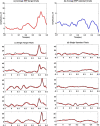Single-trial extraction of event-related potentials (ERPs) and classification of visual stimuli by ensemble use of discrete wavelet transform with Huffman coding and machine learning techniques
- PMID: 37269019
- PMCID: PMC10236727
- DOI: 10.1186/s12984-023-01179-8
Single-trial extraction of event-related potentials (ERPs) and classification of visual stimuli by ensemble use of discrete wavelet transform with Huffman coding and machine learning techniques
Abstract
Background: Presentation of visual stimuli can induce changes in EEG signals that are typically detectable by averaging together data from multiple trials for individual participant analysis as well as for groups or conditions analysis of multiple participants. This study proposes a new method based on the discrete wavelet transform with Huffman coding and machine learning for single-trial analysis of evenal (ERPs) and classification of different visual events in the visual object detection task.
Methods: EEG single trials are decomposed with discrete wavelet transform (DWT) up to the [Formula: see text] level of decomposition using a biorthogonal B-spline wavelet. The coefficients of DWT in each trial are thresholded to discard sparse wavelet coefficients, while the quality of the signal is well maintained. The remaining optimum coefficients in each trial are encoded into bitstreams using Huffman coding, and the codewords are represented as a feature of the ERP signal. The performance of this method is tested with real visual ERPs of sixty-eight subjects.
Results: The proposed method significantly discards the spontaneous EEG activity, extracts the single-trial visual ERPs, represents the ERP waveform into a compact bitstream as a feature, and achieves promising results in classifying the visual objects with classification performance metrics: accuracies 93.60[Formula: see text], sensitivities 93.55[Formula: see text], specificities 94.85[Formula: see text], precisions 92.50[Formula: see text], and area under the curve (AUC) 0.93[Formula: see text] using SVM and k-NN machine learning classifiers.
Conclusion: The proposed method suggests that the joint use of discrete wavelet transform (DWT) with Huffman coding has the potential to efficiently extract ERPs from background EEG for studying evoked responses in single-trial ERPs and classifying visual stimuli. The proposed approach has O(N) time complexity and could be implemented in real-time systems, such as the brain-computer interface (BCI), where fast detection of mental events is desired to smoothly operate a machine with minds.
Keywords: Discrete wavelet transform; Huffman coding; Machine learning classifiers; Single trials analysis (ERPs); Visual object detection.
© 2023. The Author(s).
Conflict of interest statement
The corresponding author declares on behalf of all authors that there is no conflict of interest.
Figures








Similar articles
-
Discrete wavelet transform coefficients for emotion recognition from EEG signals.Annu Int Conf IEEE Eng Med Biol Soc. 2012;2012:2251-4. doi: 10.1109/EMBC.2012.6346410. Annu Int Conf IEEE Eng Med Biol Soc. 2012. PMID: 23366371
-
Detection of Parkinson's disease from EEG signals using discrete wavelet transform, different entropy measures, and machine learning techniques.Sci Rep. 2022 Dec 29;12(1):22547. doi: 10.1038/s41598-022-26644-7. Sci Rep. 2022. PMID: 36581646 Free PMC article.
-
The CSP-Based New Features Plus Non-Convex Log Sparse Feature Selection for Motor Imagery EEG Classification.Sensors (Basel). 2020 Aug 22;20(17):4749. doi: 10.3390/s20174749. Sensors (Basel). 2020. PMID: 32842635 Free PMC article.
-
Multiresolution analysis of event-related potentials by wavelet decomposition.Brain Cogn. 1995 Apr;27(3):398-438. doi: 10.1006/brcg.1995.1028. Brain Cogn. 1995. PMID: 7626282 Review.
-
Neurophysiological Approaches to Lie Detection: A Systematic Review.Brain Sci. 2025 May 18;15(5):519. doi: 10.3390/brainsci15050519. Brain Sci. 2025. PMID: 40426690 Free PMC article. Review.
Cited by
-
Voice attractiveness affects cooperative behavior in the Stag Hunt Game: evidence from neural electrophysiology.Front Neurosci. 2025 Mar 28;19:1576757. doi: 10.3389/fnins.2025.1576757. eCollection 2025. Front Neurosci. 2025. PMID: 40224644 Free PMC article.
-
The mind & muscles: Introducing a validated EEG/EMG protocol for recording cognitive-muscular interactions in experimental archaeology.PLoS One. 2025 May 23;20(5):e0324103. doi: 10.1371/journal.pone.0324103. eCollection 2025. PLoS One. 2025. PMID: 40408369 Free PMC article.
References
-
- Quiroga RQ, Atienza M, Cantero J, Jongsma M. What can we learn from single-trial event-related potentials? Chaos Complexity Lett. 2007;2(2):345–363.
Publication types
MeSH terms
LinkOut - more resources
Full Text Sources

